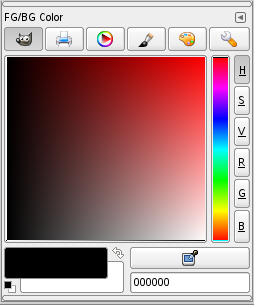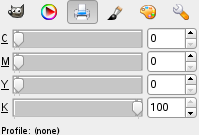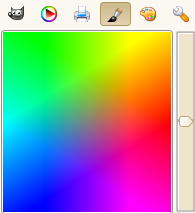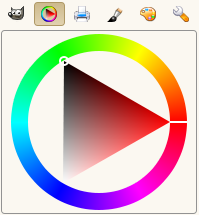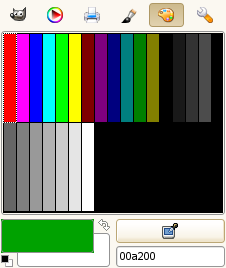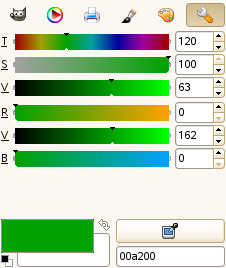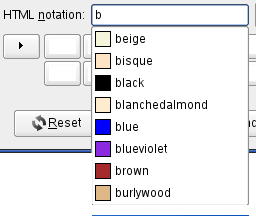Het dialoogvenster Kleur laat u kleuren beheren en kiezen. Er zijn verschillende modi die u kunt gebruiken om kleuren te kiezen. Het biedt ook een pipet om een kleur te selecteren, overal op uw scherm.
Dit dialoogvenster werkt ofwel op de voorgrond- of op de achtergrondkleur.
Dit dialoogvenster is een dokbaar dialoogvenster; zie het gedeelte Paragraaf 2.3, “Koppelen van dialoogvensters” voor hulp bij het manipuleren ervan.
U kunt het openen:
-
Uit het hoofdmenu: → → .
-
Uit het menu Tab in elk dokbaar dialoogvenster door op de knop voor menu Tab
te klikken en → te selecteren.
-
Vanuit de gereedschapskist: klik op de huidige kleur voor de Voorgrond of Achtergrond.
In het menu staat een lijst met dokbare vensters, die alleen bestaat als er ten minste een dialoogvenster geopend blijft. In dat geval kunt u het dialoogvenster “Kleuren” oproepen vanuit het hoofdmenu: → .
Het dialoogvenster biedt aan de bovenkant een aantal verschillende modi voor het selecteren van kleur:
- GIMP
-
Met de GIMP kleurkiezer selecteert u een kleur door te klikken op een een-dimensionale strip die is geplaatst aan de rechterkant en dan in een twee-dimensionaal gebied dat aan de linkerkant is geplaatst. De een-dimensionale strip kan elk van de parameters voor kleur H, S, V, R, G of B coderen, bepaald door op welke van de aansluitende knoppen wordt gedrukt. Het twee-dimensionale gebied codeert dan de twee aanvullende parameters voor de kleur.
- CMYK
-
U krijgt deze kleurkiezer door te klikken op het pictogram van CMYK. De weergave CMYK geeft u de mogelijkheid om kleuren te beheren in het kleurmodel CMYK. Als een profiel CMYK aan de afbeelding is gekoppeld, zal het profiel worden gebruikt om de kleuren CMYK te bepalen. Bekijk Profiel afdrukvoorbeeld voor meer informatie. Anders zal een "eigen" kleurconversie worden uitgevoerd.
- Waterverf
-
Deze kleurkiezer werkt iets anders dan de andere modellen. Het principe bestaat uit het wijzigen van de huidige kleur voor de voorgrond, door te klikken in het rechthoekige palet. Als de huidige kleur voor de voorgrond momenteel bijvoorbeeld wit is, dan wordt die roodachtig door te klikken in het gebied met de rode kleur. Herhaald klikken versterkt het effect. Met de schuifregelaar, die naast het kleurenpalet staat, kunt u de hoeveelheid kleur per muisklik instellen. Hoe hoger de schuifregelaar staat, hoe meer kleur per klik wordt opgenomen.
- Wiel
-
Deze kleurkiezer gebruikt het kleurmodel HSV . Klik in de gekleurde cirkel en sleep de muisaanwijzer om de Tint te selecteren. Klik-en-sleep in de driehoek om Verzadiging (verticaal) en Waarde (horizontaal) te variëren.
- Palet
-
Deze kleurkiezer brengt een lijst met kleuren van het huidige palet naar voren in het dialoogvenster Paletten. U kunt de kleuren van de voor- en achtergrond van GIMP instellen door op een van de kleuren in de kleurweergave te klikken. U kunt ook de pijltoetsen gebruiken om te verplaatsen binnen de lijst met kleuren.
- Schalen
-
Deze kleurkiezer geeft een globaal overzicht weer van de kanalen R, G, B en de waarden H, S, V of L, c, h, geplaatst in schuifbalken. De nummers kunnen worden weergegeven als 0 tot en met 255 of bereiken van 0,0 tot en met 100,0.
Aan de onderzijde zijn meer opties en gereedschappen beschikbaar:
- Voor- en achtergrondkleur
-
Het symbool dat bestaat uit twee pijlen stelt u in staat de voor- en achtergrondkleur om te wisselen. Aan de linkeronderkant van dit pictogram, onder het blok voor de voorgrondkleur, staat een oppervlak voor wisselen met twee kleine, een zwart en de ander wit, gedeeltelijk overlappende vierkanten. Als u daarop klikt worden de voor- en achtergrondkleur teruggezet naar respectievelijk zwart en wit.
- Pipet kleurkiezer
-
Het dialoogvenster Pipet heeft een volledig ander gedrag dan het gereedschap Pipet. In plaats van de kleuren te kiezen uit de actieve afbeelding, kunt u de kleuren kiezen uit het gehele scherm.
Het nadeel daarvan is dat u kleuren krijgt nadat die zijn verwerkt door de stapel met kleuren van het hele systeem, in het bijzonder kleurbeheer. Het betekent dat de resulterende kleurwaarden anders zouden kunnen zijn dan die welke worden teruggegeven door het gereedschap Pipet als uit het canvas wordt gekozen. Het is aan u om een bewuste keuze te maken welk pipet te gebruiken.
- HTML-notatie
-
Dit is een tekstveld met zes tekens. Bekijk HTML-notatie U mag ook sleutelwoorden voor CSS gebruiken; voer de eerste letter van een kleur in om een lijst met kleuren met hun sleutelwoord te krijgen:
Door met rechts te klikken in het tekstvak HTML-notatie opent een contextmenu dat u in staat stelt uw notatie te bewerken, in het bijzonder om een complexe notatie te plakken die u ergens anders hebt gekopieerd.
- Laatst gebruikte kleuren
-
Twaalf knoppen aan de onderzijde geven de laatste gebruikte kleuren weer. U kunt een kleur kiezen door te klikken op een van deze knoppen of de voor- of achtergrondkleur toevoegen aan deze lijst van de geschiedenis.
